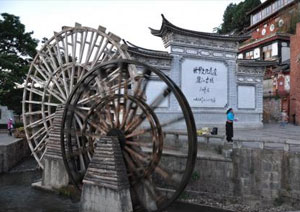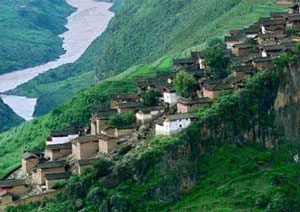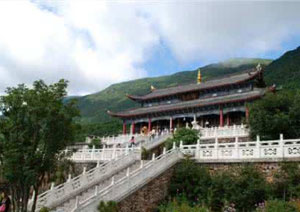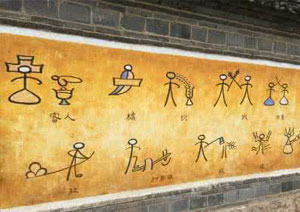Dayan Town (The ancient town of Lijiang)
 Lijiang old Town is officially called "Dayan Town", "Dayan" literally means a "great ink stab", a graphic description of the town's location on a piece of rich flatland fed by a river and surrounded by green mountains. Dayan Town is the large Naxi settlement first built during the Southern Song Dynasty some eight centuries ago. Dayan Town is one of the few places in China with well-preserved old style folk buildings. In December 1986, the State Council designated the place as a famous ancient historical and cultural city of a national caliber. In 1997, the UNESCO put Lijiang on a list of the world's major cultural heritages.
Lijiang old Town is officially called "Dayan Town", "Dayan" literally means a "great ink stab", a graphic description of the town's location on a piece of rich flatland fed by a river and surrounded by green mountains. Dayan Town is the large Naxi settlement first built during the Southern Song Dynasty some eight centuries ago. Dayan Town is one of the few places in China with well-preserved old style folk buildings. In December 1986, the State Council designated the place as a famous ancient historical and cultural city of a national caliber. In 1997, the UNESCO put Lijiang on a list of the world's major cultural heritages.
 The remarkable community of Baoshan Ancient Stone City, usually called Baoshan, is located 130km northeast of Lijiang. It comprises of more than one hundred families on the top of a gigantic rock. This town was built in the late 13th century (Yuan Dynasty). In the Naxi tongue, it is called "La Bai Lu Pan Wu". La Bai was the first local Naxi leader, who lives here. Lu Pan Wu means white stone village. This town has such a long history due to its unique geographic location. It occupied a dazzling site, high on a ridge overlooking the Upper Yangzi River (jinSha River ), surrounded by tightly ascending terraced fields . In this town, you may feel amazed at the sight of many household items made of stone. In most of the houses, their household items e.g. table, bed, water tank, cupboards are all carved out of big stones. You may wonder where they do their farming of crops. They do their planting just below this uniquely perched village.
The remarkable community of Baoshan Ancient Stone City, usually called Baoshan, is located 130km northeast of Lijiang. It comprises of more than one hundred families on the top of a gigantic rock. This town was built in the late 13th century (Yuan Dynasty). In the Naxi tongue, it is called "La Bai Lu Pan Wu". La Bai was the first local Naxi leader, who lives here. Lu Pan Wu means white stone village. This town has such a long history due to its unique geographic location. It occupied a dazzling site, high on a ridge overlooking the Upper Yangzi River (jinSha River ), surrounded by tightly ascending terraced fields . In this town, you may feel amazed at the sight of many household items made of stone. In most of the houses, their household items e.g. table, bed, water tank, cupboards are all carved out of big stones. You may wonder where they do their farming of crops. They do their planting just below this uniquely perched village.
 One of the seven largest monasteries in Lijiang, Yufeng Monastery is renowned for the giant Camellia Tree that stands in the grounds, and is known as the "Ten-thousand-flower Camellia". Yufeng Temple, located at the southern foot of Jade Dragon Snow Mountain, is 9 kilometers from the county seat of Lijiang. Yufeng Lamasery is called "Kalashicongfeilin" in Tibetan language. It lies on the east slope of Jade Dragon Snow Mountain with ancient forests clustering around. There is a small pool in front of the lamasery embraced by big pine trees.
One of the seven largest monasteries in Lijiang, Yufeng Monastery is renowned for the giant Camellia Tree that stands in the grounds, and is known as the "Ten-thousand-flower Camellia". Yufeng Temple, located at the southern foot of Jade Dragon Snow Mountain, is 9 kilometers from the county seat of Lijiang. Yufeng Lamasery is called "Kalashicongfeilin" in Tibetan language. It lies on the east slope of Jade Dragon Snow Mountain with ancient forests clustering around. There is a small pool in front of the lamasery embraced by big pine trees.
The Lamasery has three courtyards and the famous Great Camellia is in the northern one. It is said this tree was planted between 1465 and 1487 during the Ming Dynasty before the temple was built.
 Baisha is a small village 10km north of Lijiang. Although the traditional houses do not look very impressive, Baisha was the historical capital of the Naxi kingdom and is still a good place to have a glance at the Naxi culture. There are old temples with interesting frescoes, traditional musicians. The Baisha Mural was made from 1385AD to 1619 AD, employing the artist energies of Chinese Taoists, Tibetan and Naxi Buddhists and local dongba shamans. This rich fusion had resulted in a tremendously powerful art, heavy in spirit and awe-inspiring in its presentation of the mystical world. Dominated by black , silver , dark green , gold and red colors , the murals in the back hall , overlaid with centuries of brown soot , mostly depict religious stories with vivid images, colorful ethnic styles and strong local flavor, the scenes and figures , some still vivid in detail , are largely taken from Tibetan Buddhist iconography and include the wheel of life , judges of the underworld , Buddha and bodhisattvas and even Sanskrit inscriptions on the ceiling.
Baisha is a small village 10km north of Lijiang. Although the traditional houses do not look very impressive, Baisha was the historical capital of the Naxi kingdom and is still a good place to have a glance at the Naxi culture. There are old temples with interesting frescoes, traditional musicians. The Baisha Mural was made from 1385AD to 1619 AD, employing the artist energies of Chinese Taoists, Tibetan and Naxi Buddhists and local dongba shamans. This rich fusion had resulted in a tremendously powerful art, heavy in spirit and awe-inspiring in its presentation of the mystical world. Dominated by black , silver , dark green , gold and red colors , the murals in the back hall , overlaid with centuries of brown soot , mostly depict religious stories with vivid images, colorful ethnic styles and strong local flavor, the scenes and figures , some still vivid in detail , are largely taken from Tibetan Buddhist iconography and include the wheel of life , judges of the underworld , Buddha and bodhisattvas and even Sanskrit inscriptions on the ceiling.
| Lijiang Attractions List | |

